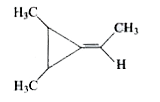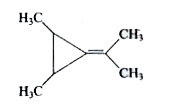Which of the following does not show optical isomerism ?
[Co(en)2Cl2]+
[Co(NH3)3Cl3]0
[Co(en)Cl2(NH3)2]+
[Co(en)3]3+
The correct Answer is:B
To determine which of the given coordination complexes does not show optical isomerism, we need to analyze the structure of each complex and identify whether they can form non-superimposable mirror images.
1. Understand Optical Isomerism:
- Optical isomerism occurs when a compound can exist in two forms that are mirror images of each other (enantiomers) and cannot be superimposed on one another. For a complex to exhibit optical isomerism, it must lack a plane of symmetry.
2. Identify the Coordination Complexes:
- The complexes given are:
- A) (Co(en)₂Cl₂)⁺
- B) (Co(NH₃)₃Cl₃)
- C) (Co(en)Cl₂(NH₃)₂)²⁺
- D) (Co(en)₃)³⁺
- Here, "en" refers to ethylenediamine, which is a bidentate ligand.
3. Analyze Each Complex:
- Complex A: (Co(en)₂Cl₂)⁺
- This complex has two bidentate ligands (en), which can form non-superimposable mirror images. Therefore, it can show optical isomerism.
- Complex B: (Co(NH₃)₃Cl₃)
- This complex consists of three monodentate ligands (NH₃) and three chloride ions. There is no bidentate ligand present, and the arrangement is symmetrical. Thus, it cannot show optical isomerism.
- Complex C: (Co(en)Cl₂(NH₃)₂)²⁺
- This complex has one bidentate ligand (en) and two monodentate ligands (NH₃). The presence of the bidentate ligand allows for the possibility of forming non-superimposable mirror images, so it can show optical isomerism.
- Complex D: (Co(en)₃)³⁺
- This complex has three bidentate ligands (en), which can also form non-superimposable mirror images. Therefore, it can show optical isomerism.
4. Conclusion:
- The only complex that does not show optical isomerism is B) (Co(NH₃)₃Cl₃) because it lacks bidentate ligands and has a symmetrical arrangement.
Final Answer:
B) (Co(NH₃)₃Cl₃) does not show optical isomerism.
- Optical isomerism occurs when a compound can exist in two forms that are mirror images of each other (enantiomers) and cannot be superimposed on one another. For a complex to exhibit optical isomerism, it must lack a plane of symmetry.
- The complexes given are:
- A) (Co(en)₂Cl₂)⁺
- B) (Co(NH₃)₃Cl₃)
- C) (Co(en)Cl₂(NH₃)₂)²⁺
- D) (Co(en)₃)³⁺
- Here, "en" refers to ethylenediamine, which is a bidentate ligand.
- Complex A: (Co(en)₂Cl₂)⁺
- This complex has two bidentate ligands (en), which can form non-superimposable mirror images. Therefore, it can show optical isomerism.
- Complex B: (Co(NH₃)₃Cl₃)
- This complex consists of three monodentate ligands (NH₃) and three chloride ions. There is no bidentate ligand present, and the arrangement is symmetrical. Thus, it cannot show optical isomerism.
- Complex C: (Co(en)Cl₂(NH₃)₂)²⁺
- This complex has one bidentate ligand (en) and two monodentate ligands (NH₃). The presence of the bidentate ligand allows for the possibility of forming non-superimposable mirror images, so it can show optical isomerism.
- Complex D: (Co(en)₃)³⁺
- This complex has three bidentate ligands (en), which can also form non-superimposable mirror images. Therefore, it can show optical isomerism.
- The only complex that does not show optical isomerism is B) (Co(NH₃)₃Cl₃) because it lacks bidentate ligands and has a symmetrical arrangement.
B) (Co(NH₃)₃Cl₃) does not show optical isomerism.
Similar Questions
Knowledge Check
- Question 1 - Select One
Which of the following will not show optical isomerism ?
ACl−CH=C=CH−ClBBr−CH=C=CH−BrC D
D
- Question 2 - Select One
Which of the following will not show optical isomerism as well as geometrical isomerism ?
A B
B C
C D
D
- Question 3 - Select One
Which of the following compound shows optical isomerism ?
ACH3CH2CH3BCH2OHCHOHCH2OHCCH3CHOHC2H5DNone of these
Which one of the following can shown optical isomerism ?
View SolutionWhich of the following compound show optical isomerism?
View SolutionWhich of the following compound show optical isomerism?
View SolutionWhich of the following does not show optical activity ?
View SolutionWhich of the following cannot show geometrical isomerism
View Solution

